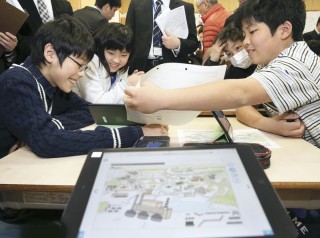▼ Disaster Education / ‘Survival Class’ Helps Pupils Prepare
- Category:Event
Some elementary schools have begun to designate disaster preparation education as a subject to be taught to students in grades one to six.
“Buildings will be buried if there’s a landslide, so we built a retaining wall.”
Children in a sixth-grade class at the municipal Hirayama Elementary School in Hino, Tokyo, were thinking about the topic “How to create a city that withstands disasters” on Feb. 18. Pretending they were the mayor and utilizing what they had learned about disaster management, the children moved schools to safe locations and built up riverbanks to prevent floods in a fictitious town on a tablet screen.
The aim of the class is to connect social studies with disaster preparation education and develop people who can be in charge of designing towns and planning the future of the nation.
Hirayama Elementary School was designated as a research and development school by the Education, Culture, Sports, Science and
Technology Ministry in the 2013 school year. The school then established an original “survival class” about disaster preparedness, although the subject is not currently included in the national school teaching guidelines.
A school official said that in the wake of the 2011 Great East Japan Earthquake, it became clear that there was a need to teach children how to survive.
Each grade has 34 to 149 sessions of the class (45 minutes per session) every school year. The school has provided a total of 146 sessions for sixth-grade students by transferring integrated study classes and sections of social studies, science and homemaking classes already related to disaster management to the subject, plus squeezing in other learning activities between classes. The students are then given written evaluations on their report cards.
With the cooperation of university professors and other disaster management specialists, the children obtain basic knowledge about earthquakes, typhoons and heavy rain, and also learn about self-protection, first aid and life in evacuation shelters. During class, sixth-grade primary school students also make proposals for disaster management such as a subsidy system for earthquake-proof homes and policies to promote measures to fix furniture.
Sixth-grade student Mikihisa Ono, 12, said, “Even if a disaster occurs in my town, I think I can respond to it well now.”
There is still no prospect of disaster preparation education becoming part of the national curriculum, as has been discussed since the 2011 disaster. Principal Toshiko Igarashi of the elementary school said: “Disaster management education needs to be taught systematically. One-off lessons aren’t effective.” She said her school will continue to run the survival class even after the research period is over next school year.
The municipal Shichigo Elementary School in Sendai, whose school district was partly hit by tsunami triggered by the Great East Japan
Earthquake, was also designated by the ministry as a research and development school in the 2013 school year. The school established an original “disaster management and safety class.”
Each grade takes the class roughly once a week. The sixth-grade students think about what they can do for their region in the event of a disaster after listening to stories of tsunami survivors over 16 sessions.
If there is an earthquake warning, children in the schoolyard immediately squat down and keep away from the school building. Children in classrooms crawl under their desks and hold onto the desk legs. This response has now become natural for them.
Vice Principal Masaki Nakatsuji, 57, said: “Learning disaster preparation helps us live with ease. We want our students to have the abilities to cope with disasters and pass those on to future generations.”
- March 30, 2017
- Comment (0)
- Trackback(0)


